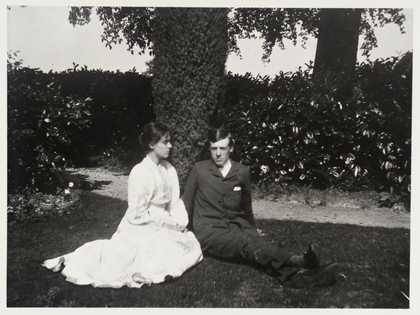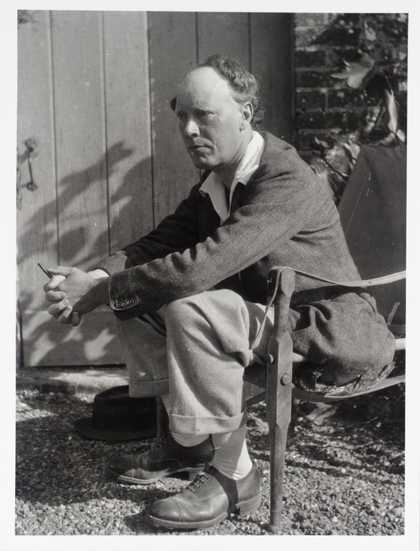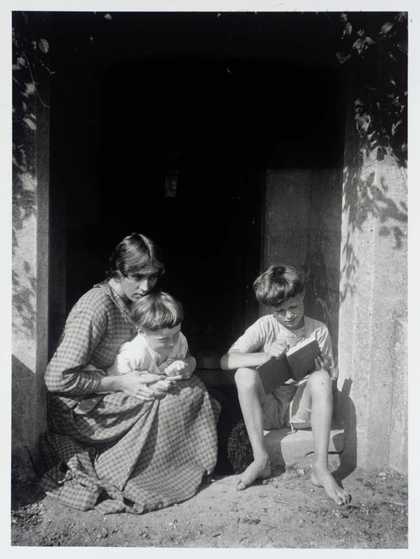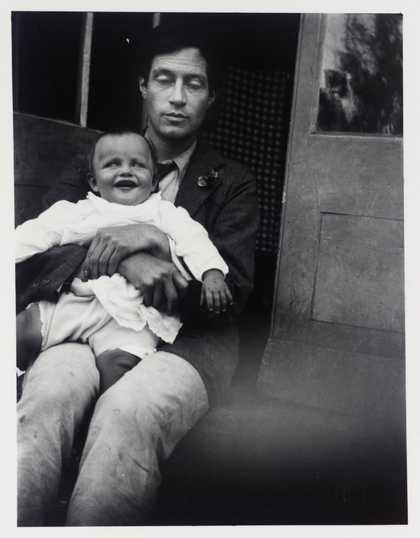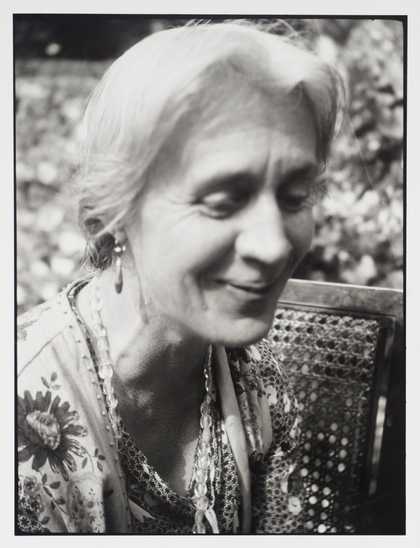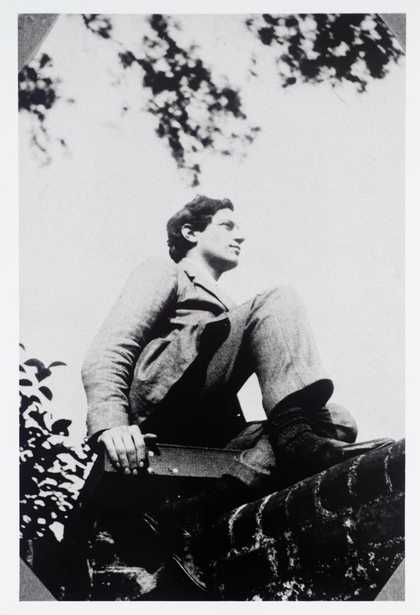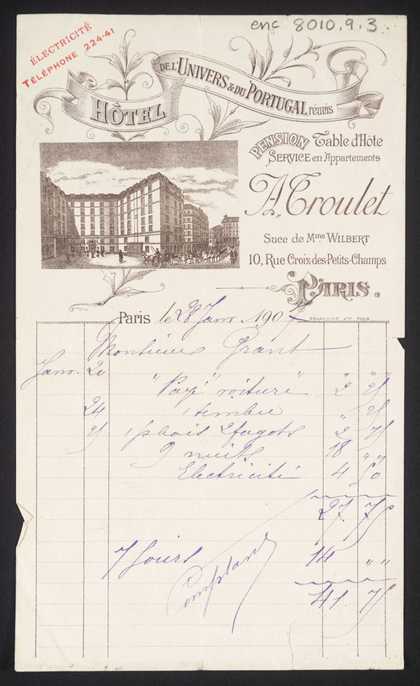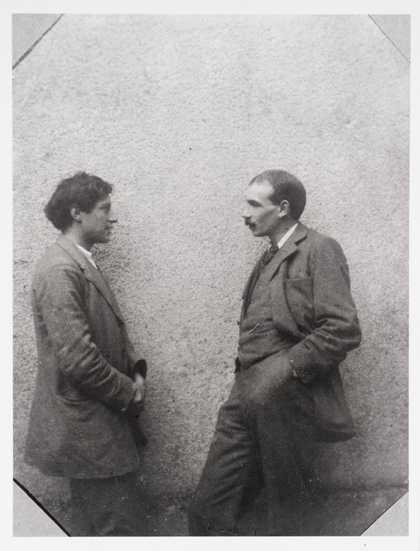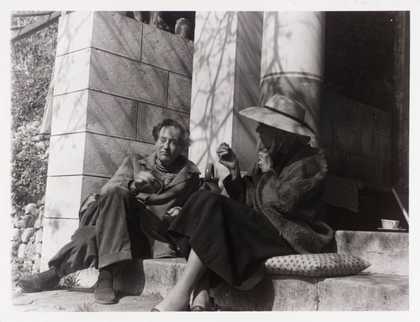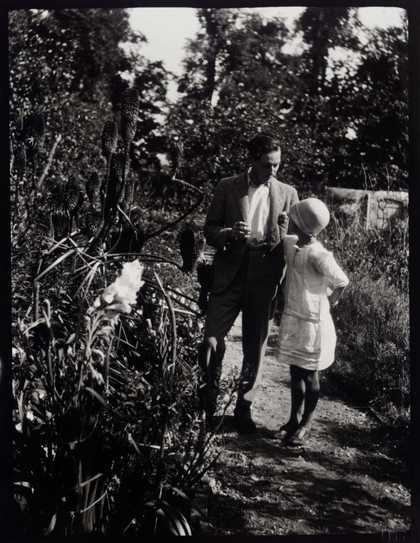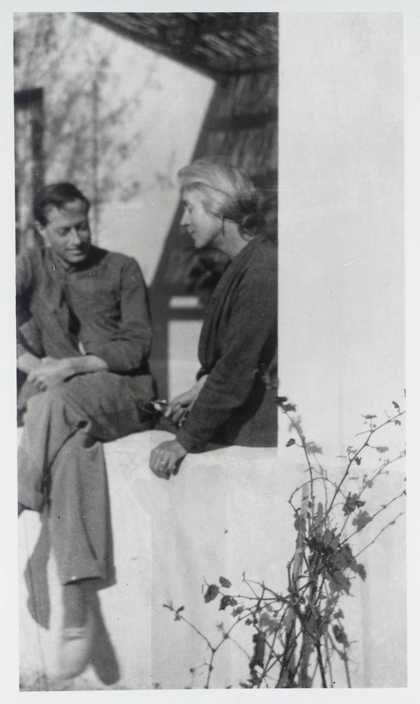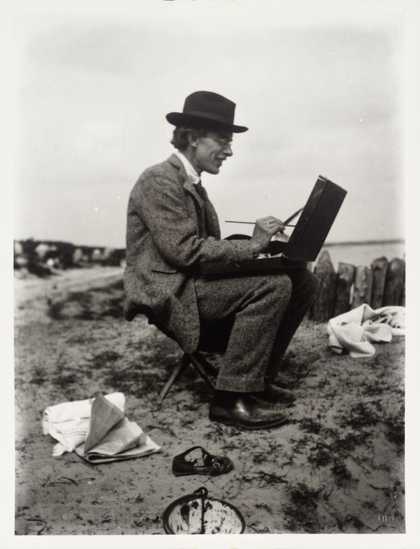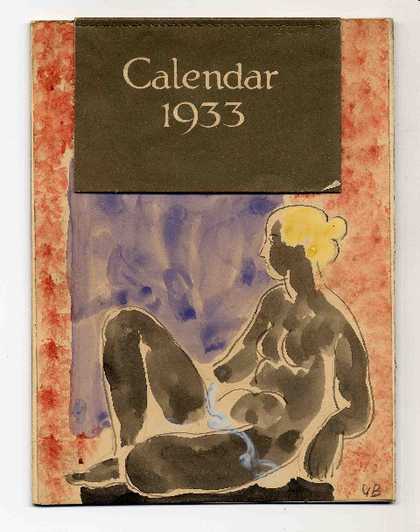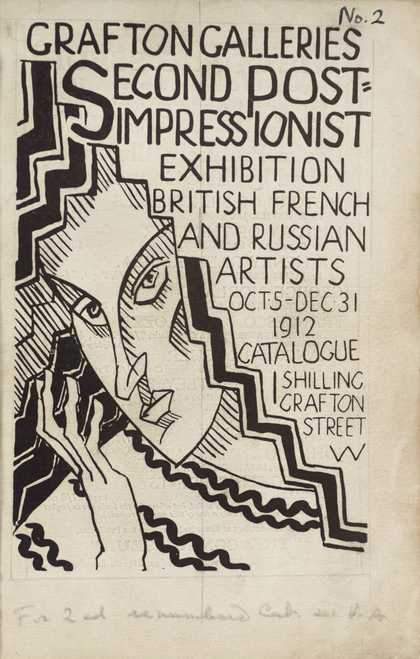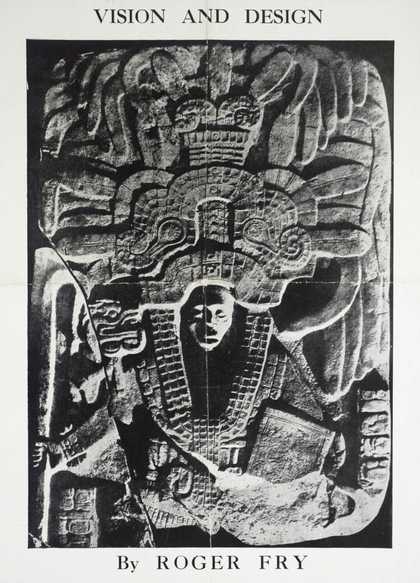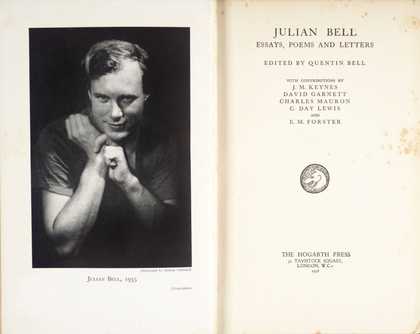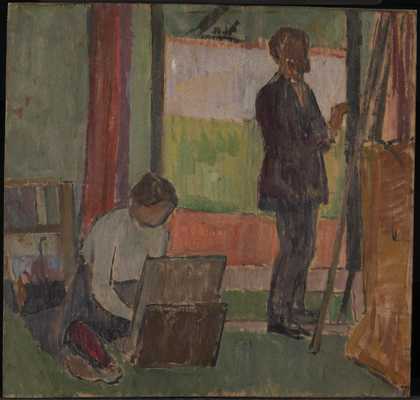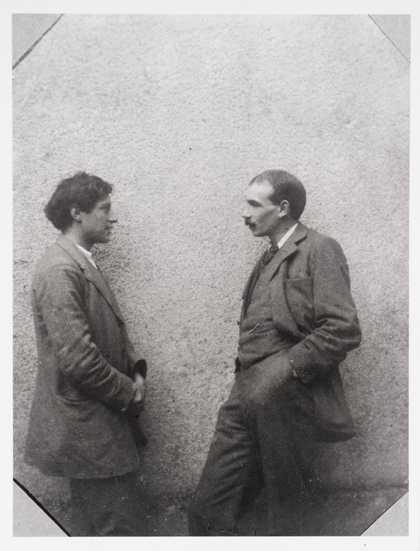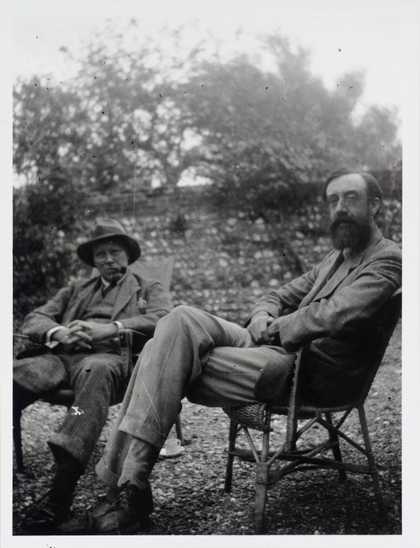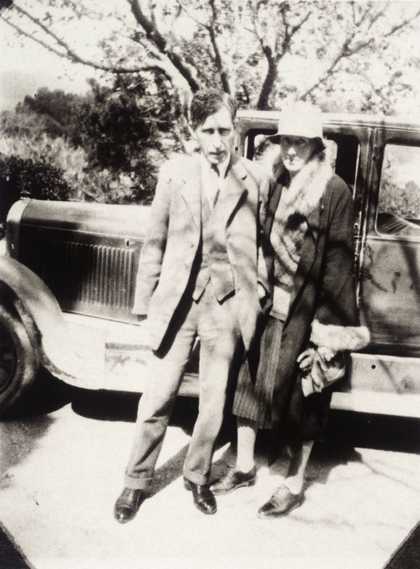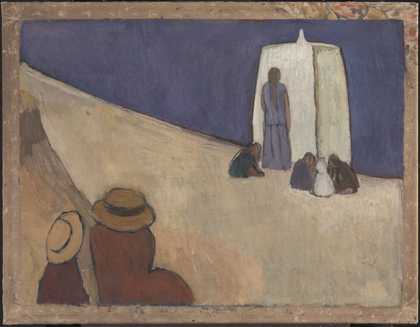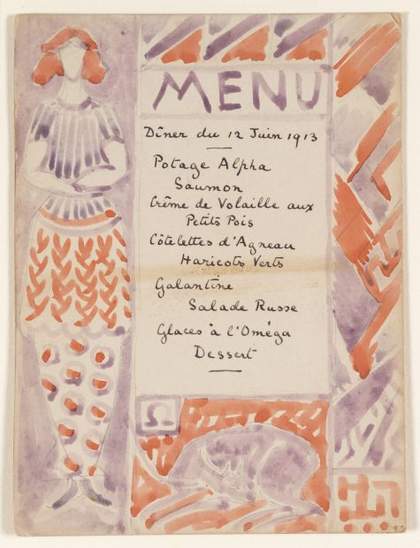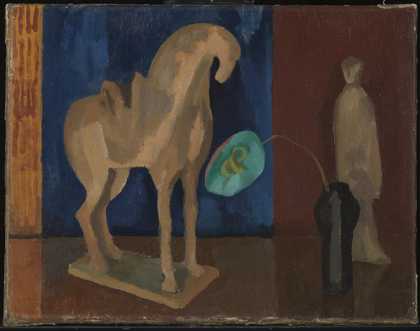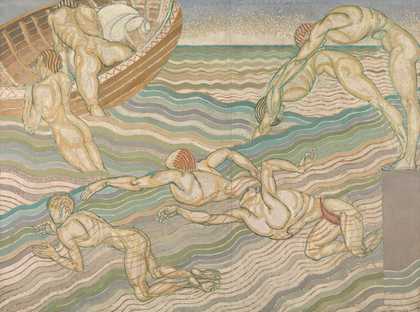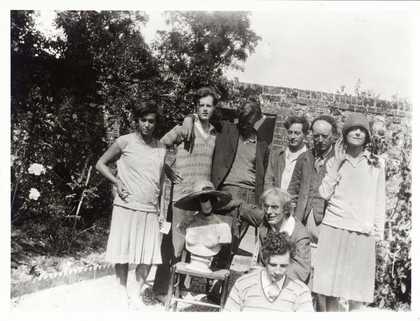
Photograph of family and friends of Vanessa Bell in the walled garden of her home, Charleston farmhouse, in Firle, Sussex.
© Tate
Introduction
In 1905 a group of writers, artists and intellectuals began to meet at the London home of the artist Vanessa Bell and her writer sister Virginia Woolf. They shared ideas, supported each other’s creative activities and formed close friendships. The group became known as the Bloomsbury Group and their meetings continued for the next thirty years.
Why 'Bloomsbury'?
The artists and intellectuals who were part of the group lived and worked in Bloomsbury in central London. This is a district of garden squares surrounded by elegant town houses. The group was first called ‘Bloomsbury’ in 1912 when Vanessa Bell, Duncan Grant and other artist friends showed their work at an exhibition, the Second Post-Impressionist Exhibition, organised in London by their art critic friend Roger Fry.
Who were they?
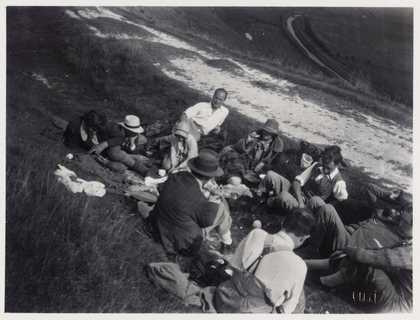
Group picnic at High and Over, Sussex
© Tate
The writers and the artists
The Bloomsbury Group was formed from two different sets of people, the writers and the artists.
The writers group met on Thursdays for drinks and conversation at the home Vanessa and her brothers and sister shared at 46 Gordon Square, London. It was started by Vanessa Bell’s brother Thoby Stephen and was made up of his university friends who were writers and critics. Key members of the group included the writer Lytton Strachey, art critic Clive Bell, publisher Leonard Woolf and the economist John Maynard Keynes. Another key member, writer and publisher David Garnett, was introduced to the group by artist Duncan Grant during the First World War.
The Friday Club provided the focus for the artist members of the Bloomsbury Group. It was started in 1905 by Vanessa Bell and some of her friends from art school. They met to talk about their work and ideas, discuss what was happening in the wider art world, and organise exhibitions. In a letter, Vanessa Bell discusses why they met in her house rather than hiring a public space to hold meetings:
The chief one seems to me to be that, as you say, we should have to eradicate politeness. We can get to the point of calling each other prigs and adulterers quite happily when the company is small & select, but its rather a question whether we could do it with a larger number of people who might not feel that they were quite on neutral ground
Vanessa Bell, Letter from Vanessa Stephen to Clive Bell, n.d. [1905]
![Letter from Vanessa Stephen [Bell] to Clive Bell about the Friday Club, Tate Archive](https://media.tate.org.uk/aztate-prd-ew-dg-wgtail-st1-ctr-data/images/lettervanessaclivebellfridayclubresized.width-420.jpg)
Letter from Vanessa Stephen [Bell] to Clive Bell about setting up the Friday Club, n.d. [1905]
Executor of the Estates of Vanessa Bell and Duncam Grant © Henrietta Garnett. All rights reserved.
As well as Vanessa and her art school friends; artists Duncan Grant, John Nash, Henry Lamb and Edward Wadsworth were Friday Club members. Art critic Roger Fry was introduced in 1910 and became an important influence on the group. Their exhibitions were held in small galleries in London such as the Baillie and the Alpine Club Gallery. After 1912 the Friday Club was replaced by the Grafton Group, another exhibiting society, organised by Roger Fry.
Lifestyle and beliefs
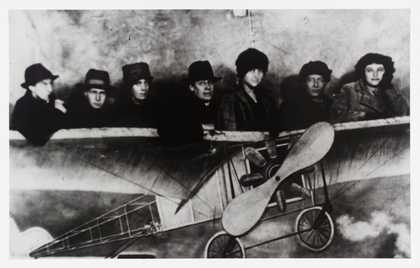
Artists and friends in a fake plane. From left to right: Unknown, David Garnett, Vanessa Bell, Oliver Strachey, Dora Carrington, Duncan Grant, and Barbara Bagenal
© Tate
Above all, the personalities that counted as far as the inhabitants of Gordon Square and Charleston were concerned were their own: what Virginia had to say about Lytton, whether Duncan was sleeping with Vanessa or Maynard, and whether Roger and Clive knew or cared.
Charles Derwent, The Independent on Sunday, 7 November, 1999
The Bloomsbury Group are often better known for their unconventional personalities and lifestyles than for their art. What was it about them that outraged people at the time and still fascinates people today?
They came from wealthy backgrounds, which had given them social advantages and self-confidence. But they were linked by a spirit of rebellion against what they saw as the unnecessary conventions, restraints and double standards of their parents’ generation. They wanted freedom to develop their own ideas and lifestyles. They were politically liberal. They also had liberal ideas about sex, which meant there were often complicated relationships and affairs between the various members of the Bloomsbury circle.
Charleston farmhouse
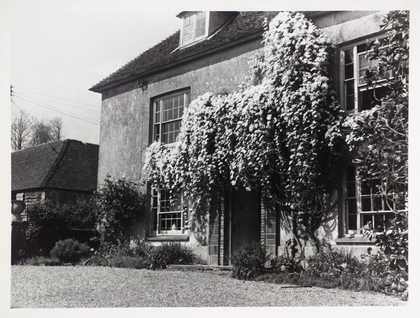
Charleston farmhouse in Firle, Sussex, home of Vanessa Bell and Duncan Grant.
© Tate
The social life of the Bloomsbury circle revolved around the various houses members and their friends owned. Charleston farmhouse was Vanessa Bell’s house in the Sussex countryside. She moved there during the First World War with her children and her close friend the artist Duncan Grant. David ‘Bunny’ Garnett (another Bloomsbury Group member and Duncan’s current lover) also moved in with them; as did a nurse, a housemaid, a cook – and Duncan’s dog Henry.
This is how Vanessa described Charleston in a letter to her friend Roger Fry:
It’s most lovely, very solid & simple, with flat walls in that lovely mixture of brick & flint that they use about here, & perfectly flat windows in the walls & wonderful tiled roofs. The pond is most beautiful with a willow at one side & a stone – or flint – wall edging it all round the garden part, & a little lawn sloping down to it, with formal bushes on it. Then there’s a small orchard & the walled garden…& another lawn or bit of field railed in beyond. There’s a wall of trees – one single line of elms all round two sides which shelters us from west winds.
Letter from Vanessa Bell to Roger Fry
Although a big house, it was quite run down. The garden was overgrown and inside there was no telephone, central heating or electricity. But it was in a beautiful setting, on a gentle slope overlooking stunning countryside.
Duncan and Vanessa chose rooms for their studios and immediately started to decorate the house. Walls, fireplaces, door panels and furniture were all decorated in the style of their paintings. Fabrics and ceramics designed by the Omega Workshops, (a design company started by Bloomsbury member Roger Fry), were included in the overall design.
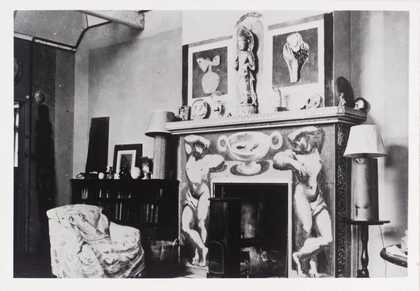
Photograph of interior decorations at Charleston farmhouse
© Tate
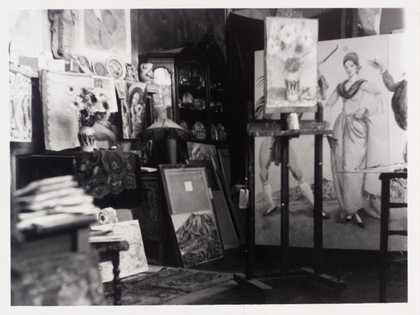
Photograph of interior decorations at Charleston farmhouse
© Tate
House parties were common at Charleston and it was often full of guests. They were captured on camera by Vanessa Bell, a keen photographer.
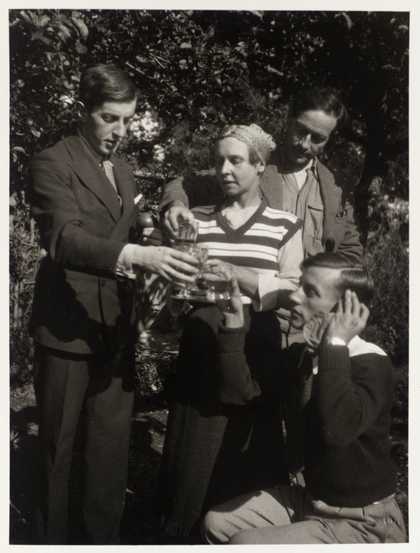
Frederick Ashton, Lydia Lopokova, Duncan Grant and Billy Chappell drinking a toast in the garden at Charleston
© Tate
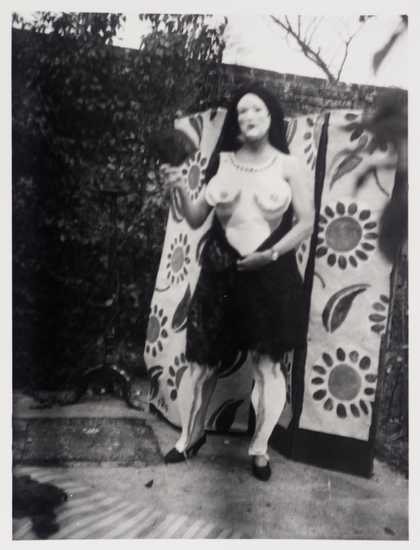
Photograph of Duncan Grant in costume as a Spanish dancer, at Charleston
© Tate
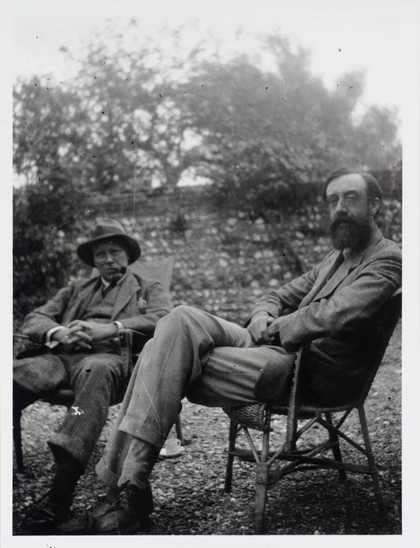
Photograph of Clive Bell and Lytton Strachey in the garden at Charleston
© Tate
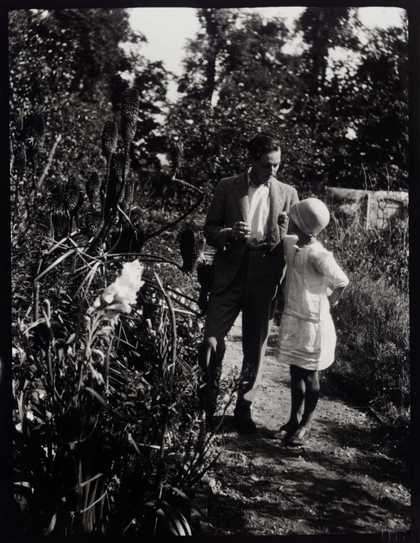
Duncan Grant and Angelica Bell in the garden of Charleston farmhouse in Sussex, 1927
© Tate
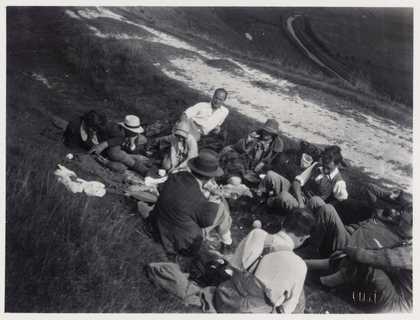
Group picnic at High and Over, Sussex
© Tate
In 1916, the artist Dora Carrington was invited to stay at Charleston. She described the experience in a letter to her friend, giving us a fascinating peep inside the house and the lifestyle of its inhabitants.
It was indeed a romantic house buried deep down in the highest & most wild downs I have ever seen. Duncan Grant was there, who is much the nicest of them & Strachey with his yellow face & beard. Ugh! I used to walk along the ridge of the downs every morning early when the sun was just rising. And the wind of the top was more fierce & powerful than anything you could imagain [sic]. It roared in my ears. And I had to lie flat down on the wet grass in order to look at the land below & the sea beyond Newhaven which shone all silver.
We lived in the kitchen & cooked & ate there. All the time I felt one of them would suddenly turn into mother and say ‘what brekfast [sic] at 10.30! Do use the proper butter knife!’ – But no. Everything was behind time. Everyone devoid of table manners. & the vaguest cooking insued [sic] – Duncan earnestly putting remains of milk pudding into the stockpot! They were astounded because I knew what part of the leak [sic] to cook! What poseurs they are really-Letter from Dora Carrington to Christine Nash, n.d. [Dec. 1916]
Bloomsbury lives

Vanessa Bell sitting outside her home, Charleston farmhouse in Sussex, 1928
© Tate
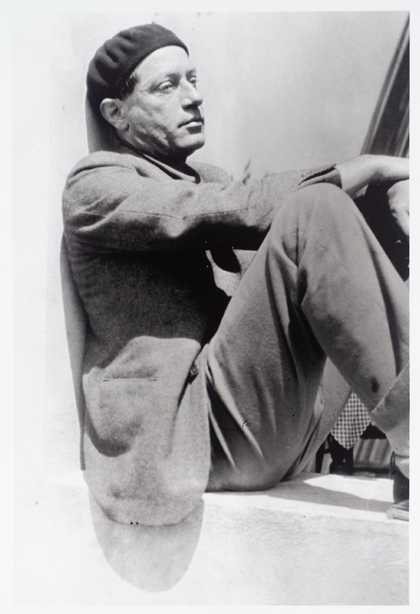
Duncan Grant at La Bégère, the house he shared with Vanessa Bell, near Cassis in the South of France, 1938
© Estate of Vanessa Bell
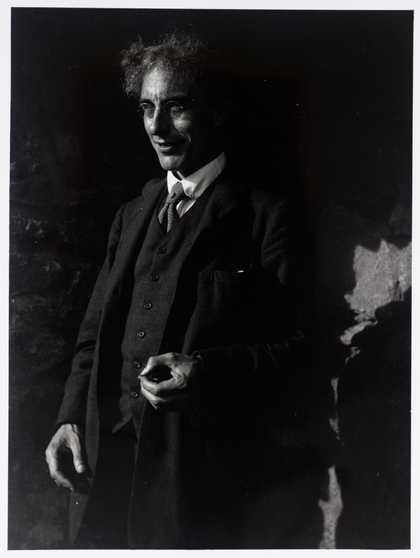
Roger Fry
© Tate
A variety of personalities both literary and artistic made up the Bloomsbury Group. They were friends, lovers and family members.
At its centre were three extraordinary people whose backgrounds, interests, relationships and achievements shaped its development. They were Vanessa Bell, Duncan Grant and Roger Fry. Using photographs and documents from Tate's archives, get some personal glimpses into their lives and relationships, and find out about other members of the Bloomsbury circle.
Vanessa Bell
How did a young woman who grew up in a strict, respectable Victorian family become a painter at the centre of a hub of unconventional bohemians?
Early life
Vanessa Stephen (later Bell) was born in May 1879 in London. She was the eldest of four children of the Victorian scholar and writer Leslie Stephen, and his second wife Julia Duckworth. Vanessa and her brothers and sister Thoby, Adrian, and Virginia (later Virginia Woolf) were educated at home, and were encouraged to develop their individual talents. Vanessa started having drawing lessons and went to study art at the Royal Academy Schools in London in 1899.
After her mother’s death in 1895, Vanessa took on the role of housekeeper for her demanding father and family, and was forced to balance this domestic role with trying to develop her artistic interests. However after her father’s death in 1904 the family home was sold and Vanessa moved with her sister and brothers to a new life at 46 Gordon Square, Bloomsbury. In their new house they were able to entertain their own friends, rather than their father’s, and the Bloomsbury Group was born.
Marriage, friends and lovers
Vanessa and Clive
Clive Bell, a friend of Vanessa’s brother Thoby, asked Vanessa to marry him twice – in 1905 and 1906 – but she refused. In a letter she explains why:
…for you see if marriage were only a question of being very good friends & of caring for things in the same way I could say yes at once. I like you much better than I like any other man I suppose one ought to say! outside my own family, & I am sure that our friendship means quite as much to me as it can to you. But I suppose that something more is wanted which now I don’t feel.
Letter from Vanessa Stephen to Clive Bell, July 31 1906
However, after the sudden death of her brother Thoby from typhoid fever in 1907, Vanessa changed her mind and accepted Clive’s proposal. Two sons, Julian and Quentin were born in 1908 and 1910. Although Vanessa continued to paint, her time was increasingly taken up with looking after her sons. Clive Bell, in a letter to Virgina Woolf moans about the effect motherhood has on their relationship: 'I see nothing of Nessa. I do not even sleep with her; the baby takes up all her time'.
Vanessa and Roger
In 1911 Vanessa Bell began a relationship with Roger Fry. The relationship began when Roger nursed Vanessa through illness while on holiday with the Bells in Greece and Turkey. Although she was still married to Clive, they had grown apart after the children were born and Clive went back to a previous lover. Clive and Vanessa remained friends however, and he continued to support her financially.
Vanessa and Duncan
Another friend who joined the Bloomsbury Group was Duncan Grant. Vanessa admired his work and purchased one of his paintings, Lemon Gatherers 1910. She fell in love with Duncan and ended her affair with Roger Fry. Despite Duncan Grant’s promiscuous homosexuality, they were devoted to each other and lived together for the rest of her life. In 1918 the couple had a daughter, Angelica. Although the Bloomsbury Group generally rejected the strict morality of the time, Duncan and Vanessa pretended Angelica was the daughter of Vanessa’s husband Clive Bell. (Angelica herself only discovered that Duncan Grant was her biological father when she was nineteen).
Sadness in later years
The deaths of some of the people who were closest to her made the 1930s and 1930s a time of sadness for Vanessa Bell.
In 1934 Roger Fry, who Vanessa had remained close to, died after a fall. Then three years later in 1937, Vanessa’s son Julian was killed while serving as an ambulance driver in the Spanish Civil War. As a pacifist as well as a mother, Vanessa Bell had tried her best to dissuade her son from going to war, as can be seen in a letter she wrote to him in 1936:
I understood your wanting to go and see what war was like… only I do think nearly all war is madness. It’s destruction and not creation, and it’s mad to destroy the best things and people in the world, if one can anyhow avoid it. You object to cutting down trees. Isn’t war that, a million times worse?
Letter from Vanessa Bell to Julian Bell, 10 Oct 1936
More unhappiness followed with the suicide of her sister Virginia in 1941, and a falling-out with her daughter Angelica. Angelica married David Garnett, her father Duncan Grant’s former lover in 1942. Although the Bloomsbury circle had lead unconventional lives, Vanessa was unwilling to accept this complicated entanglement.
During Vanessa’s last years she lived at Charleston which remained a great inspiration for her painting. She died in 1961.
Duncan Grant
He was charismatic, passionate, good looking and gay (at a time when homosexuality was illegal in England). Duncan Grant was introduced to the Bloomsbury Group in 1905 when his cousin Pippa Strachey took him to a meeting of the Friday Club.
Starting out
Duncan Grant was born in Scotland in 1885. His father was a major in the army, and much of his early childhood was spent in India and Burma. He returned to England in 1894 to go to school. He enjoyed art classes and was encouraged by his art teacher and also his aunt Lady Strachey, who organised private drawing lessons for him. Eventually, he was allowed to become an artist, rather than joining the army as his father wanted. He went to Westminster School of Art in 1902.
Duncan Grant’s cousins the Stracheys, who he had spent summer holidays as a schoolboy, played an important part in his life during this time. He spent the summer of 1905 with Lytton Strachey, and around the same time Pippa Strachey took Duncan to a meeting of the Friday Club where he first met the Bloomsbury artists.
Paris 1906-7
In early 1906 Duncan Grant went to Paris to follow his dream of becoming an artist. He had a letter of introduction from the French artist Simon Bussy (a family friend who knew artists in Paris including Henri Matisse) and £100 from a kind aunt. He enrolled at Jacques Emile Blanche’s new art school, La Palette.
In an interview with Tate Archivist Sarah Whitfield in 1970, he talked about his Paris adventure:
The extraordinary thing is I managed to live there a year on £100 – seems incredible now… I went with some of these people from Westminster School, and we all shared the top floor of a very big, old hotel near the Palais Royale which was called l’Hotel de l’Univers et de Portugal and it was incredibly cheap. The rooms ran out of one another, there was no passage or anything.
During his year in Paris Duncan made a number of important friendships. He met the British artists Wyndham Lewis, Henry Lamb and Augustus John. He also met the influential collectors Leo and Gertrude Stein. The Steins’ impressive art collection and their connections with European avant-garde artists such as Henri Matisse and Pablo Picasso had a huge impact on the development of Grant’s painting style.
Relationships
Back in London, Duncan Grant formed relationships over the next few years that affected the course of life and also the development of his painting. In 1908, he became romantically involved with Maynard Keynes, a university friend of his cousin Lytton Strachey. They travelled widely in Europe, seeing lots of sights that would influence Grant’s artistic style.
In 1913 his friendship with Vanessa Bell, who shared many of his ideas about art, developed into a relationship. In 1918 Vanessa gave birth to Duncan’s child, Angelica. Duncan and Vanessa worked closely on artistic projects and, though Duncan would have many parallel relationships with men, they remained close companions for the rest of their lives.
In a letter to her son Julian written over twenty years later, Vanessa describes what it is about Duncan's character that she loves:
He is so incredibly full of charm, his genius as an artist seems to overflow so into his life and character & he is so amusing too and odd and unaccountable that lots of people I think don’t see clearly what to me is really his most adorable quality – his honesty – disinterestedness absolute sincerity & simplicity of character which make me depend upon him always.
Letter from Vanessa Bell to Julian Bell, 7 Mar 1937
The war and Charleston
Duncan Grant, like most of the Bloomsbury circle, was a pacifist. In order to avoid fighting during the First World War, he realised he would have to do some sort of useful non-military work. He and his current lover David ‘Bunny’ Garnett, who he had begun a relationship in 1915, moved to Wissett in the Suffolk countryside to become farm labourers. Although they were at first refused exemption by a tribunal, they appealed and were eventually recognised as conscientious objectors.
In 1916 Grant and Garnett moved with Vanessa Bell and her children to Charleston Farmhouse in Sussex, where they also found work on the land during the war. After the war they kept the house on and it provided a welcome escape from London.
In a letter to Vanessa Bell in 1925 Duncan Grant commented: 'Well it’s very nice after all this sordid town life to be here again. The quiet and peace and beauty are unbelievable'.
Later years
Duncan Grant enjoyed success as an artist from the 1920s onwards. He had his first one-man exhibition in 1920 and his work was exhibited regularly until 1977. He spent much of his later life travelling in Europe and spending time in the house he shared with Vanessa Bell in the South of France. As well as developing his own painting career, Duncan Grant and Vanessa Bell were in great demand to paint murals and house decorations.
After Bell’s death in 1961 Duncan Grant continued painting, dividing his time between Charleston and London and also travelling to Turkey, Morocco and France.
He died in 1978 of pneumonia.
Roger Fry
Roger Fry was key to the success of the Bloomsbury Group and the reputation they enjoyed. As an artist, designer, art critic, theorist, curator and company director he was also the most multi-talented of the group. He first met Clive and Vanessa Bell in 1910. They invited him to lecture at Vanessa’s Friday Club, and introduced him to their artist friends.
Fry is a slim, clean-shaven man, wearing his hair long, a curl at the end and parted in the middle. He has large spectacles, a large folding smiling mouth, bright merry eyes.
Sir Michael Sadler, notes on a lecture given by Roger Fry, 9 Jan 1911
Roger Eliot Fry was born in 1866 in Highgate, London, into a wealthy Quaker family. Although studying science at Cambridge University, he became interested in art. Much to his family’s regret, he decided after university to pursue an artistic career rather than continue his scientific studies.
Personal life
Although Fry’s chosen career as an artist and critic was a success, his personal life was troubled. His wife, the artist Helen Coombe, suffered from mental illness and had to be committed to an institution in 1910. Roger was left to look after their two children Pamela and Julian. In 1913 the affair he had begun with Vanessa Bell ended when she fell in love with Duncan Grant. Fry was heartbroken. In a letter written four years later, his feelings for Vanessa are still very strong:
Don’t forget my dear that I am getting a rather bad hunger to spend a few quick days with you…it would be an enormous pleasure so I trust you to plan it as far ahead as possible. I’ll always arrange for you at Guildford in the mid week if you can come.
Letter from Roger Fry to Vanessa Bell, June 11 1917
It was not until 1924 after several short lived relationships that he found happiness with Helen Anrep. Twenty years his junior and unhappily married to the artist Boris Anrep, she became a great support to Fry in his career and lived with him until his death.
Fry died on 9 September 1934 following a fall at his London home. His ashes were placed in the vault of Kings College Chapel, Cambridge, in a casket decorated by Vanessa Bell.
Pioneer of British Modernism
Roger Fry became one of the most important art historians and critics of his generation. His early writings focused on the old masters, but it is for his ideas and writing about the development of modern art that he is best known.
He was important to the development of modern art in Britain, both as a thinker and as a curator. He emphasised the importance of ‘form’, (how an artwork looks), over ‘content’, (what an artwork is about). He thought that artists should focus on how they use colour and composition (the arrangement of the different elements within their work) to express their ideas and feelings. He also suggested that artworks should not be judged by how realistic they look. Fry championed the work of Cézanne who experimented with colour and form, and ignored accurate perspective. He also admired Vincent van Gogh, who painted what he felt even if this meant distorting what he saw.
Two exhibitions that he curated, Manet and the Post-Impressionists in 1910 and the Second Post-Impressionist Exhibition two years later, brought work by contemporary European artists including Matisse and Picasso to England. The exhibitions Fry organised rocked the London art establishment and had a great impact on the work of young British artists, including artists of the Bloomsbury circle. For many it was their first encounter with post-impressionist art. Fry was praised as a champion of modern art.
Roger Fry also brought modernism into designs for the home. In 1917 he opened Omega Workshops Ltd. The Workshops employed young avant-garde artists to design and decorate furniture, fabrics and household accessories. The artists took the simple flat shapes and bold colours of of their art and used them in their designs.
Fry as critic
Roger Fry updated a collection of his best articles and writings in his book Vision and Design which was published in 1920. As well as Western art, the book examined art from Africa, America and Asia.
It was a great success, strengthening his position as England’s leading critic. Vision and Design is still recognised as an important book in the development of ideas about modern art.
Other Bloomsbury Group members
Helen Anrep
Supporter of the arts and long-term partner of Roger Fry.
Helen Anrep became involved with the Bloomsbury circle in 1924-5 when she met Roger Fry at a party at Vanessa Bell’s studio. She left her husband Boris Anrep, an artist who made mosaics, to be with Fry. She lived with Fry until his death. Although not an artist or intellectual, Anrep was interested in the arts and provided critical support for Fry in his work. After his death she continued her interest and generously supported the artists of the Euston Road School in the late 1930s.
Clive Bell
Art critic who was married to Vanessa Bell, and was the father of Julian and Quentin.
Clive Bell met through Vanessa through her brother Thoby. Although Vanessa and Clive separated soon after their two sons were born they remained friends, and Clive continued to support her financially. Clive Bell helped Roger Fry organise the two post-impressionist exhibitions (in 1910 and 1912), and went on to write Art published in 1914. Like his friend Roger Fry's writing on art, Bell’s writing emphasised the importance of ‘form’ over ‘content’. (He suggested that what a work of art looks like – its colours, shapes and the arrangement of the things within a work of art, is more important than what the subject of the work is – what its about). His theory of ‘significant form’ proposed by Bell was was an important influence on British art and art writing between the First and Second World Wars.
Julian Bell
Son of Vanessa and Clive Bell, brother of Quentin Bell and half-brother of Angelica Garnett.
Julian Bell was the older son of Clive and Vanessa Bell. He had an unconventional upbringing and spent much of his childhood in the relative isolation of Charleston. A writer and poet he also became interested in left wing politics. He was killed in 1937 while serving as an ambulance driver in the Spanish Civil War.
Quentin Bell
Son of Vanessa and Clive Bell, brother of Julian Bell and half-brother of Angelica Garnett.
Quentin Bell was the second son of Clive and Vanessa Bell. He spent much of his childhood at Charleston and went on to become a writer, artist, and art historian.
Frederick and Jesse Etchells
Artists and friends of Vanessa Bell.
Frederick and his sister Jesse were artists and members of the Friday Club. Frederick met Georges Braque and Pablo Picasso whilst living in France, was friendly with Wyndham Lewis and collaborated with Duncan Grant on the Borough Polytechnic Murals. Paintings by Frederick Etchells were included in the 1912 Second Post-Impressionist Exhibition in London organised by Roger Fry. Frederick was also a founder member of the Omega Workshops but left after falling out with Fry. He was associated with the art movement vorticism, and went on to became a successful architect.
Angelica Garnett
Daughter of Vanessa Bell and Duncan Grant, married to David Garnett.
Angelica Garnett was the daughter of Vanessa Bell and Duncan Grant. She did not learn that Clive Bell, her mother's husband, was not her father until she was nineteen (although this was well known in Bloomsbury circles). She spent her childhood at Charleston and in the South of France and went on to become an actress and artist. She collaborated with Vanessa Bell and Duncan Grant on the murals they painted for Berwick Church. Much to her parents horror, she married David Garnett, her father’s former lover, in 1942.
David ‘Bunny’ Garnett
Writer and lover of Duncan Grant, who married Grant's daughter Angelica Garnett.
David Garnett was a writer. He first met members of the Bloomsbury group in 1910 but was not fully accepted by them until 1914 when he became Duncan Grant’s lover. Like Grant, Garnett was a conscientious objector. He worked in France in 1915 with the Friends War Victims Relief Mission and worked as a farm labourer to avoid conscription on his return to England. Garnett moved with Duncan Grant and Vanessa Bell to Charleston farmhouse in 1916. He married Angelica Garnett in 1942.
Maynard Keynes
Key Bloomsbury member and supporter.
A brilliant economist who enjoyed a successful and influential career, Keynes became involved with Bloomsbury through his relationship with Duncan Grant who met in 1905. He did much to help his artist friends and support the arts more generally, and was the main force behind the London Artists Association and the Contemporary Arts Society. Keynes’s recruitment to the Treasury as a negotiator and advisor during the First World War lead to a cooling off in his relationship with the Bloomsbury artists as his position clashed with their pacifist ideals. He did however use his influence to obtain military exemptions for Grant, the Strachey brothers and David Garnett. Keynes married Lydia Lopokova, a ballerina with the Russian Ballet, in 1925. In the 1940s he was appointed chairman of CEMA (Council for the Encouragement of Music and the Arts) which later became The Arts Council.
Wyndham Lewis
Painter and writer and early associate of Roger Fry and Clive Bell.
Wyndham Lewis was a painter and writer who was associated with the Bloomsbury Group until late 1913. His work was included in the Second Post-Impressionist Exhibition organised by Roger Fry in 1912. He was one of the main figures behind the Omega Workshops, the design company run by artists and started by Fry. He left Omega after a quarrel with Fry and went on to establish his own movement vorticism which aimed to reflect modern technology in art.
Lytton Strachey
Biographer and writer and cousin of Duncan Grant.
Strachey became involved with Bloomsbury through his friendship with Vanessa Bell’s brother Thoby Stephen. A mainstay of Bloomsbury’s ‘Thursday evenings’ and an important figure within the Bloomsbury circle, he also introduced his cousin Duncan Grant to the group. Lytton Strachey became famous overnight for his satirical book Eminent Victorians which was published in 1918. The book was a collection of texts mocking leading Victorian figures.
Leonard Woolf
Writer and publisher married to Virginia Woolf.
Writer and political observer Leonard Woolf met Thoby Stephen (Vanessa Bell's brother), Lytton Strachey and Clive Bell at Cambridge University. He married Virginia Stephen, Vanessa’s sister, who he was devoted to and supported throughout her life. He was deeply involved with the activities of the Bloomsbury Group and helped Roger Fry with the organisation of the Second Post-Impressionist Exhibition. He founded the Hogarth Press with Virginia Woolf in 1917 which published books by important 20th century writers including T.S. Eliot and Katherine Mansfield – as well as books by Virginia Woolf. The Hogarth Press also published translations of works of Russian literature by Chekhov, Tolstoy and others. Artists including Vanessa Bell, Graham Sutherland and William Nicholson were invited to design the covers for the books giving them a distinctive house style.
Virginia Woolf
Writer and sister of Vanessa Bell, married to Leonard Woolf.
Novelist, biographer and critic, Virginia Woolf was an active member of London’s social and literary circles throughout her life. She developed a modernist style of writing that can be seen to echo the Bloomsbury painters’ investigations into technique. Acting as a hostess for the ‘Thursday evenings’ discussion group of writers and critics, she was very much at the heart of Bloomsbury. She set up the Hogarth Press with her husband Leonard Woolf, which provided Bloomsbury artists with the opportunity of book illustration. She was also one of the Omega Workshops’ important customers. (Omega Workshops was set up by Roger Fry partly to provide the artists he knew with an income designing household textiles, furniture and ceramics). Virginia Woolf suffered from bouts of depression throughout her life and committed suicide in 1941.
Influence and achievements
Groundbreakers or dabblers?
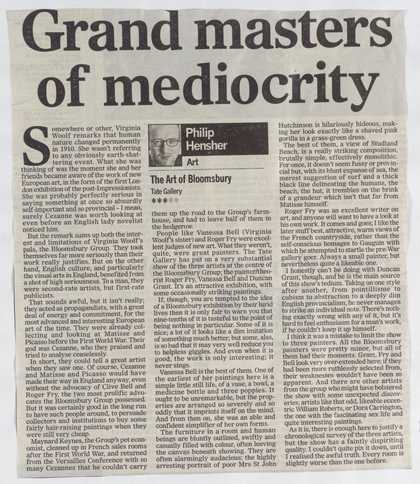
Mail on Sunday review of Tate’s Bloomsbury exhibition in 1999
© Associated Newspapers Ltd.
The Bloomsbury Group has had its critics. They have been criticised for their elitist lifestyles, and their art has sometimes been dismissed as decorative and unoriginal. A Mail on Sunday review of Tate’s 1999 Bloomsbury exhibition commented: ‘they took themselves far more seriously than their work really justifies’.
Although Bloomsbury artists enjoyed great success during their lifetimes, it is often argued that the bold artistic innovations shown in the years immediately before the First World War, were watered down in later Bloomsbury work. In the 1930s a new generation of artists emerged which included Paul Nash, Ben Nicholson, Barbara Hepworth and Henry Moore. With their more direct abstract style and interest in socialist ideals, these younger artists seemed more in tune with modern life.
What was their legacy?
So how important were the Bloomsbury Group? What was the influence of their life and work? What did they achieve?
Artistic legacy
Many of the members of the Bloomsbury circle were important thinkers and innovators and their achievements should not be overshadowed by their backgrounds and lifestyle. They mixed with important European avant-garde artists, writers and musicians. In 1917 Clive Bell wrote to Vanessa from Paris and said:
Bloomsbury is altogether to the fore – the name of Grant is pronounced with respect among the artists, and that of Keynes among the intellectuals, that of Lytton Strachey among the ‘lettres’.
Clive Bell in a letter to Vanessa Bell, n.d. [Nov. 1919?]
When Clive Bell made this observation he was mingling with important cultural figures including the artist Pablo Picasso, the writer Jean Cocteau and the composer Eric Satie. That the names of the Bloomsbury artists and intellectuals were known in these circles suggests the extent of their reputation.
Although the art of Bloomsbury may today look rather traditional when compared with later twentieth-century art, their influence and contribution to British art was important. Fry, Bell, and Grant were amongst the first artists in Britain to make purely abstract paintings.
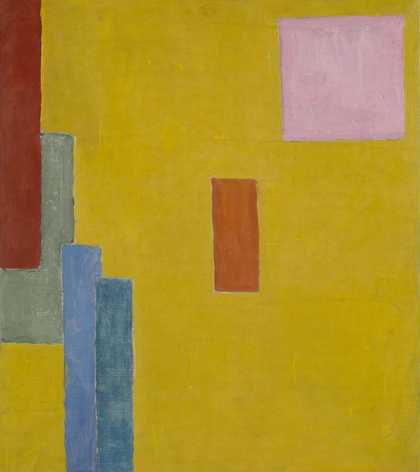
Vanessa Bell
Abstract Painting (c.1914)
Tate
The artist and critic Roger Fry was one of the most important figures in British art in the first half of the century. His writings, collected in his book Vision and Design in 1920, along with Clive Bell’s book, simply called Art, published in 1914, were among the most influential art writing of the time. They did much to shape the development of modernism.
The two exhibitions Fry organised, Manet and the Post-Impressionists in 1910 and the Second Post-Impressionism Exhibition in 1911-12, introduced the work of contemporary European artists to England. (The 1912 exhibition is still the most comprehensive survey of post-impressionist art that has been displayed in this country). For many young British artists this was their first encounter with post-impressionism, and led to them experimenting with colour and abstraction.
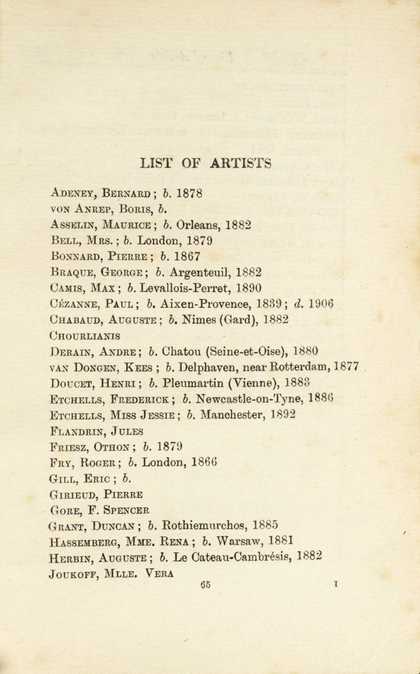
List of artists included in the Second Post-Impressionist Exhibition at the Grafton Galleries in London, with Duncan Grant and Vanessa Bell listed alongside Paul Cézanne and Georges Braque. Courtesy Tate Archive
Nurturing creative environments
Perhaps the Bloomsbury Group’s most important artistic contribution was the focus and support it gave to young artists. In this, its role was central to the development of art during the early 20th century.
The Friday Club, and Grafton Group offered young artists the opportunity to meet, share ideas, and exhibit their work. The London Artists Association was founded largely as a result of the inspiration and hard work of Bloomsbury members, particularly Maynard Keynes. This provided artists with a means of selling their work. The establishment of the Contemporary Art Society, whose mission was to raise funds to purchase contemporary works of art to present to museums and galleries (Tate has a number of CAS assisted acquisitions), as also set up through the hard work of Bloomsbury members.
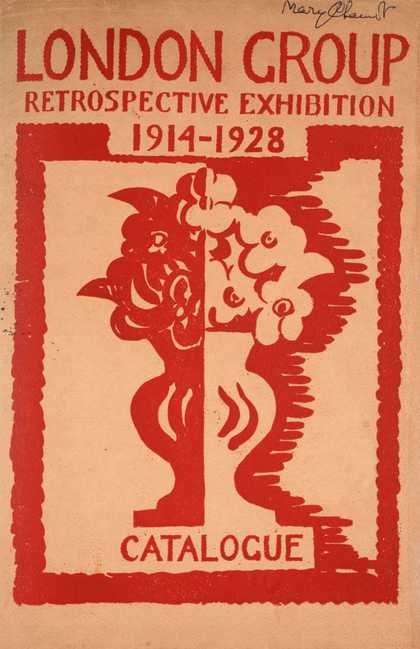
Catalogue for London Group Retrospective Exhibition, 1928
© Tate
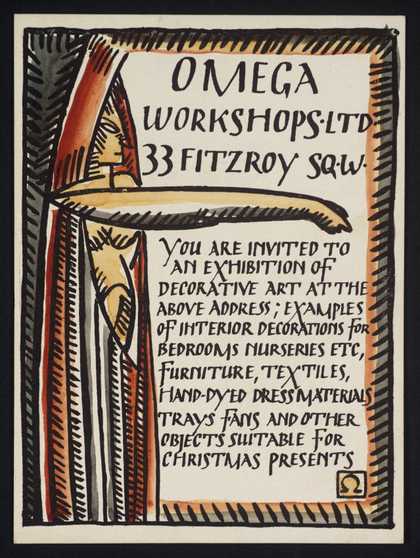
A private view card probably designed by Duncan Grant for the opening exhibition at the Omega Workshops in 1913
© Henrietta Garnett. All rights reserved.
The Omega Workshops, brought together some of the most talented young artists of the day and provided financial support for them. Many of these such as Wyndham Lewis and Paul Nash, went on to become major figures in British art. Omega also encouraged links between designers and fine artists, and many of the furnishings, textiles and ceramics it made still look surprisingly modern today, a century later.
Vanessa Bell and Duncan Grant continued to support younger artists throughout their lives, most notably those in the Euston Road School in the 1930s.
Literary legacy
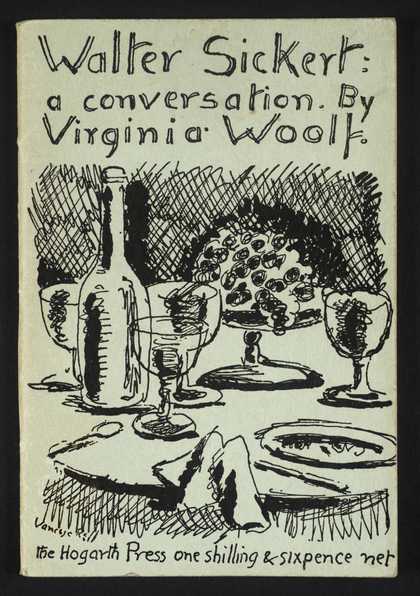
Hogarth Press publication, Walter Sickert: a conversation, by Virginia Woolf, with cover design by her sister Vanessa Bell.
The Hogarth Press, set up in 1917 by Leonard and Virginia Woolf to publish contemporary fiction and political comment published work by some of the most important writers of the twentieth century. Virginia Woolf, T.S.Eliot, Katherine Mansfield and E.M.Forster were among its writers. It also later published translations of the writings of Sigmund Freud, one of the most influential thinkers of the twentieth century.

